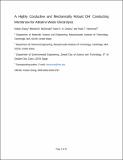| dc.contributor.author | Zhang, Ketian | |
| dc.contributor.author | McDonald, Michael | |
| dc.contributor.author | Genina, Islam E. A. | |
| dc.contributor.author | Hammond, Paula T | |
| dc.date.accessioned | 2020-06-15T17:39:58Z | |
| dc.date.available | 2020-06-15T17:39:58Z | |
| dc.date.issued | 2018-09 | |
| dc.date.submitted | 2018-09 | |
| dc.identifier.issn | 0897-4756 | |
| dc.identifier.issn | 1520-5002 | |
| dc.identifier.uri | https://hdl.handle.net/1721.1/125798 | |
| dc.description.abstract | In an alkaline water electrolysis cell, a membrane is needed between the cathode and the anode to avoid mixing of hydrogen and oxygen products while enabling OH- transport. Hydroxide ion conductivity and membrane mechanical properties are both important parameters that determine material constraints on low electrical resistance of a membrane versus sufficient structural integrity. Herein, we demonstrate a strategy to make membranes with both high OH- conductivity and mechanical strength. A chemically tailored OH- conducting polymer (qPPO) was synthesized via amination and subsequent quaternization of poly(2,6-dimethyl-1,4-phenylene oxide) (PPO) and was blended with poly(vinyl alcohol) (PVA) to provide an environment analogous to basic water solutions. The -OH groups in PVA provide high-density Grotthuss mechanism conduction sites similar to water, which may be the key reason for the observed high OH- conductivity of the membranes. The PVA backbone was cross-linked to form a semi-interpenetrating network (semi-IPN) of PVA and qPPO; the resulting material contains PVA chemical cross-links and hydrogen bonds between PVA and qPPO and between PVA with itself, all of which are believed to contribute to a high tensile strength. By tuning the PVA/qPPO ratio, the transport and mechanical properties were optimized. The membrane with 30% qPPO possesses both extraordinary conductivity (151 mS/cm at room temperature) - about 2.7 times as high as Nafion 117 in acidic conditions - and high ultimate tensile strength (126 MPa (dry), 41 MPa (wet)). This highly conductive polymer membrane also exhibits stability in alkaline water electrolysis at room temperature, a property that makes qPPO an interesting and potentially translational material for the design of hydroxide-based electrochemical cells. | en_US |
| dc.description.sponsorship | National Science Foundation (Grant CHE-1305124) | en_US |
| dc.language.iso | en | |
| dc.publisher | American Chemical Society (ACS) | en_US |
| dc.relation.isversionof | http://dx.doi.org/10.1021/acs.chemmater.8b02709 | en_US |
| dc.rights | Article is made available in accordance with the publisher's policy and may be subject to US copyright law. Please refer to the publisher's site for terms of use. | en_US |
| dc.source | Prof. Hammond via Ye Li | en_US |
| dc.title | A Highly Conductive and Mechanically Robust OH– Conducting Membrane for Alkaline Water Electrolysis | en_US |
| dc.type | Article | en_US |
| dc.identifier.citation | Zhang, Ketian et al. "A Highly Conductive and Mechanically Robust OH– Conducting Membrane for Alkaline Water Electrolysis." Chemistry of Materials 30, 18 (September 2018): 6420–6430 © 2018 American Chemical Society | en_US |
| dc.contributor.department | Massachusetts Institute of Technology. Department of Materials Science and Engineering | en_US |
| dc.contributor.department | Massachusetts Institute of Technology. Department of Chemical Engineering | en_US |
| dc.relation.journal | Chemistry of Materials | en_US |
| dc.eprint.version | Author's final manuscript | en_US |
| dc.type.uri | http://purl.org/eprint/type/JournalArticle | en_US |
| eprint.status | http://purl.org/eprint/status/PeerReviewed | en_US |
| dc.date.updated | 2020-06-08T16:39:20Z | |
| dspace.date.submission | 2020-06-08T16:39:23Z | |
| mit.journal.volume | 30 | en_US |
| mit.journal.issue | 18 | en_US |
| mit.license | PUBLISHER_POLICY | |
| mit.metadata.status | Complete | |

